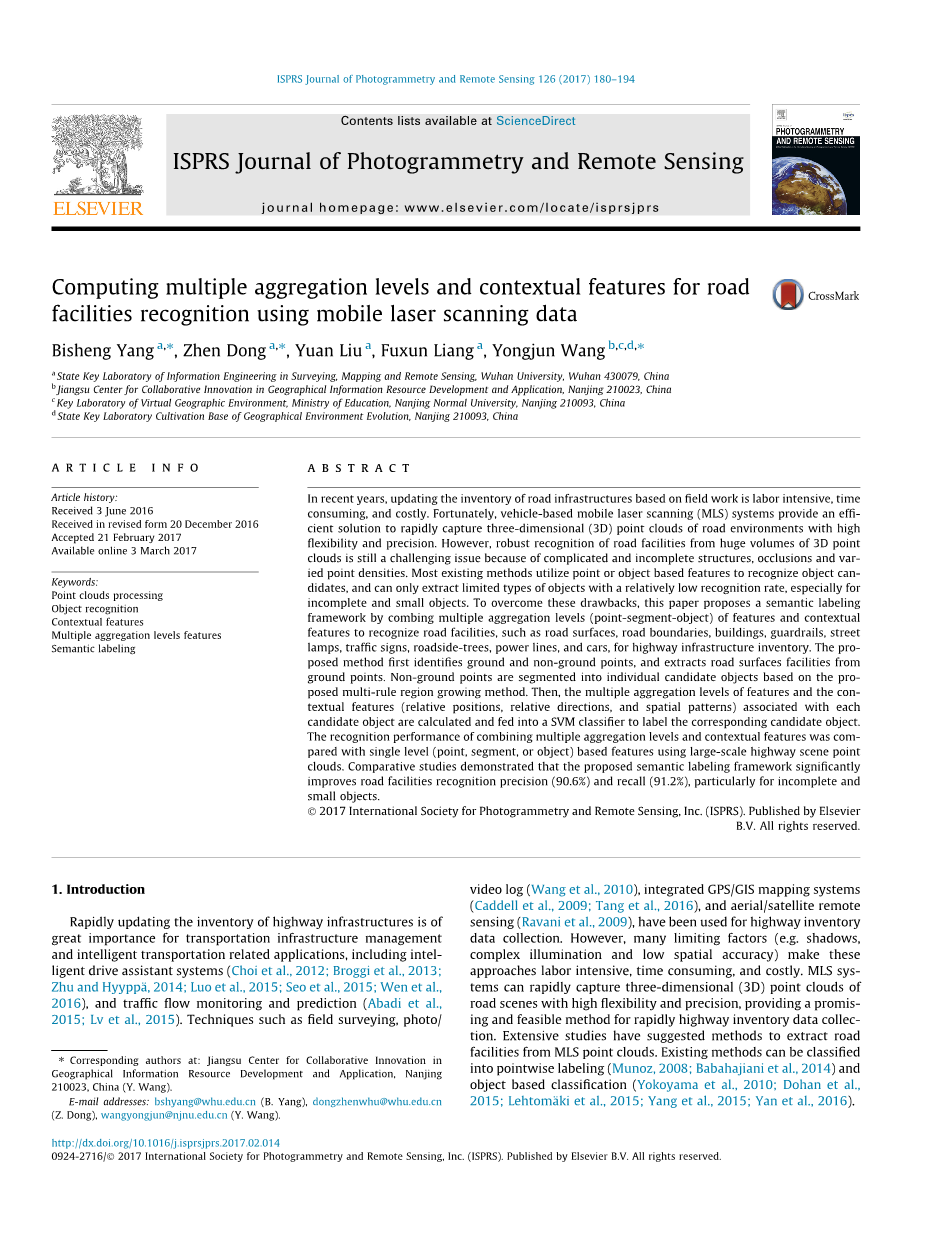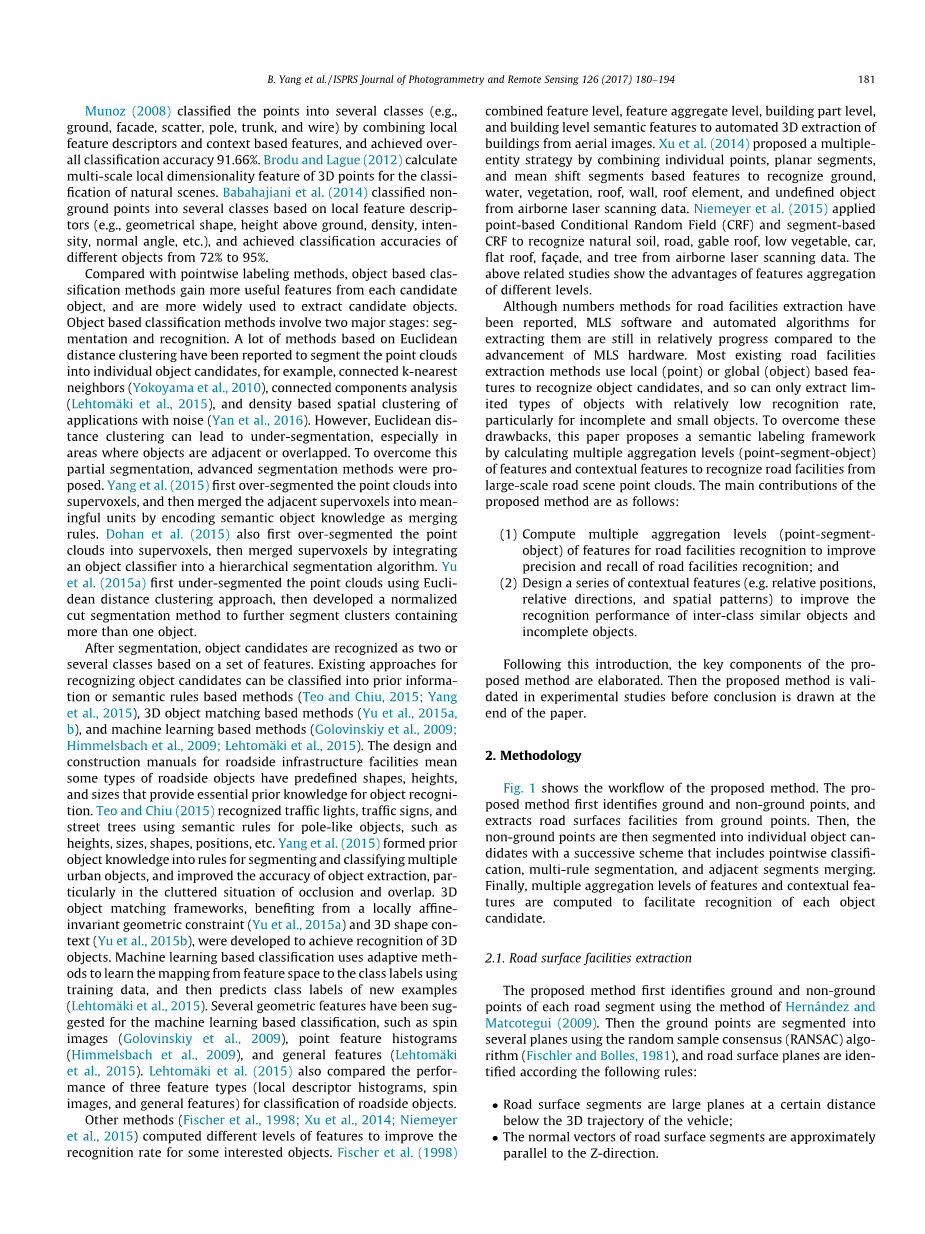

英语原文共 15 页,剩余内容已隐藏,支付完成后下载完整资料
利用移动激光扫描计算多聚合级功能和周边特征数据识别道路设施
Bisheng Yang,Zhen Dong,Yuan Liu,Fuxun Liang,Yongjun Wang
(1.State Key Laboratory of Information Engineering in Surveying, Mapping and Remote Sensing, Wuhan University, Wuhan 430079, China;2. Jiangsu Center for Collaborative Innovation in Geographical Information Resource Development and Application, Nanjing 210023, China;3. Key Laboratory of Virtual Geographic Environment, Ministry of Education, Nanjing Normal University, Nanjing 210093, China;4. State Key Laboratory Cultivation Base of Geographical Environment Evolution, Nanjing 210093, China)
摘要:近年来,基于现场作业的道路基础设施的维护工作是劳动密集型、耗时、成本高的。幸运的是,车辆的移动激光扫描(MLS)系统提供了一种有效的解决方案,以便快速捕获道路环境的三维(3D)点云,具有高灵活性和高精度。然而,由于复杂和不完整的结构、遮挡和VAR IED点密度,大量的3D点云对道路设施的鲁棒识别仍然是一个具有挑战性的问题。大多数现有的方法是利用基于点或基于对象的特征来识别可以被分割的对象,并且只能提取具有相对辨识度低的有限类型的对象,特别是对于不完整的和比较小的对象。为了克服这些缺点,本文提出了一种语义标记框架,通过结合周边特征的多个集聚水平(点段对象)来识别道路设施,如道路表面、道路边界、建筑物、护栏、路灯、交通标志、路侧树、电力线和汽车,用于公路基础设施清单。提出的方法首先要识别地面和非地面点,并从地面点提取路面设施。根据提出的多规则区域生长方法将非接地点分割成单个筛选对象。然后,计算与每个候选对象相关联的特征的多个集聚水平和相关周围特征(相对位置、相对方向和空间模式),并将其馈送到SVM分类器中,以标记对应的筛选对象。将多个集聚水平和周边特征相结合的识别性能与基于大规模公路场景点云的单级(点、段或对象)特征相结合。比较研究表明,所提出的语义标记框架显著提高道路设施识别精度(90.6%)和召回(91.2%),特别是对于不完整的和较小的对象。
关键词:点云处理;对象识别;周边特征;多聚合级功能;语义标注
Computing multiple aggregation levels and contextual features for road facilities recognition using mobile laser scanning data
Bisheng Yang,Zhen Dong,Yuan Liu,Fuxun Liang,Yongjun Wang
(State Key Laboratory of Information Engineering in Survey[1]ing, Mapping and Remote Sensing, Wuhan University, Wuhan 430079, China;2. Jiangsu Center for Collaborative Innovation in Geographical Information Resource Development and Application, Nanjing 210023, China;3. Key Laboratory of Virtual Geographic Environment, Ministry of Education, Nanjing Normal University, Nanjing 210093, China;4. State Key Laboratory Cultivation Base of Geographical Environment Evolution, Nanjing 210093, China)
Abstract:In recent years, updating the inventory of road infrastructures based on field work is labor intensive, time consuming, and costly. Fortunately, vehicle-based mobile laser scanning (MLS) systems provide an effi- cient solution to rapidly capture three-dimensional (3D) point clouds of road environments with high flexibility and precision. However, robust recognition of road facilities from huge volumes of 3D point clouds is still a challenging issue because of complicated and incomplete structures, occlusions and var- ied point densities. Most existing methods utilize point or object based features to recognize object can- didates, and can only extract limited types of objects with a relatively low recognition rate, especially for incomplete and small objects. To overcome these drawbacks, this paper proposes a semantic labeling framework by combing multiple aggregation levels (point-segment-object) of features and contextual features to recognize road facilities, such as road surfaces, road boundaries, buildings, guardrails, street lamps, traffic signs, roadside-trees, power lines, and cars, for highway infrastructure inventory. The pro- posed method first identifies ground and non-ground points, and extracts road surfaces facilities from ground points. Non-ground points are segmented into individual candidate objects based on the pro- posed multi-rule region growing method. Then, the multiple aggregation levels of features and the con- textual features (relative positions, relative directions, and spatial patterns) associated with each candidate object are calculated and fed into a SVM classifier to label the corresponding candidate object. The recognition performance of combining multiple aggregation levels and contextual features was com- pared with single level (point, segment, or object) based features using large-scale highway scene point clouds. Comparative studies demonstrated that the proposed semantic labeling framework significantly improves road facilities recognition precision (90.6%) and recall (91.2%), particularly for incomplete and small objects.
Key words:Point clouds processing;Object recognition;Contextual features;Multiple aggregation levels features;Semantic labeling
说明
快速更新公路基础设施库存对于交通基础设施管理和智能交通相关应用具有重要意义,包括智能驾驶辅助系统(Choi et al., 2012; Broggi et al., 2013; Zhu and Hyyppauml;, 2014; Luo et al., 2015; Seo et al., 2015; Wen et al., 2016)和交通流量监测和预测(Abadi et al., 2015; Lv et al., 2015)。像野外测量,照片/视频日志(Wang et al., 2010),综合GPS/GIS制图系统(Caddell et al., 2009; Tang et al., 2016)和航空/卫星遥感(Ravani et al., 2009)等技术已被用于公路库存数据的采集。然而,许多限制因素(例如阴影、复杂照明和低空间精度)使得这些方法劳动密集、耗时且成本高。MLS系统可以快速捕捉道路场景的三维(3D)点云,具有很高的灵活性和精度,为快速公路库存数据采集提供了一种有前途和可行的方法。广泛的研究已经提出了从MLS点云中提取道路设施的方法。现有的方法可分为逐点标记法(Munoz, 2008; Babahajiani et al., 2014)和基于对象的分类(Yokoyama et al., 2010; Dohan et al., 2015; Lehtomauml;ki et al., 2015; Yang et al., 2015; Yan et al., 2016)。
Munoz (2008) 通过将局部特征描述符和基于上下文的特征相结合,将这些点分类为若干类(例如,地面、立面、散射、极、躯干和线材),并获得总体分类精度91.66%。Brodu and Lague (2012) 计算自然场景分类的三维点的多尺度局部维数特征。Babahajiani et al. (2014)基于局部特征描述符(例如几何形状、地面上的高度、密度、强度、法向角等)将非地面点划分为若干类,并实现从72%到95%的不同对象的分类精度。
与逐点标记方法相比,基于对象的CLAS分类方法从每个候选对象中获得更多有用的特征,并被更广泛地用于提取候选对象。基于对象的分类方法包括两个主要阶段:图形化和识别。许多基于欧几里得距离聚类的方法已经被报道用于将点云分割成单独的对象候选,例如,连接的k近邻(Yokoyama et al., 2010),连通成分分析(Lehtomauml;ki et al., 2015),和基于密度的具有噪声的应用程序的空间聚类(Yan et al., 2016)。然而,Euclidean DIS聚类可能导致欠分割,特别是在对象相邻或重叠的区域。为了克服这部分分割,提出了先进的分割方法。Yang et al. (2015)首先将点云分割成超体素,然后通过将语义对象知识编码为合并规则,将相邻的超体素合并成有意义的单元。此外,Dohan et al.
资料编号:[245569],资料为PDF文档或Word文档,PDF文档可免费转换为Word


